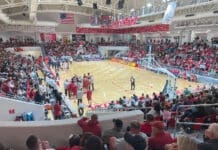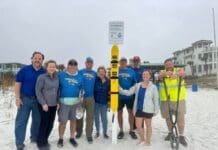By Lori Smith and Rita L. Sherwood
 Each year, thousands of sea turtles nest on our beaches. Florida beaches are the No. 1 place for sea turtle nests in North America from May to October. Northwest Florida beaches attract many endangered species including Green, Loggerhead, Leatherback and Kemps Ridley.
Each year, thousands of sea turtles nest on our beaches. Florida beaches are the No. 1 place for sea turtle nests in North America from May to October. Northwest Florida beaches attract many endangered species including Green, Loggerhead, Leatherback and Kemps Ridley.
Life Media’s own “Theo,” the Gulfarium C.A.R.E. Center, Destin-Fort Walton Beach Sea Turtle Patrol and the Florida Fish and Wildlife Commission (FWC) remind locals and visitors to help protect nesting sea turtles by practicing some simple tips.
Clean:
We can all do our part to protect the sea turtles by keeping the beach clean. Remove all belongings, including trash, when you leave the beach. Leave no trace! Stash the trash! Obstacles on the beach can prevent sea turtles from nesting as they crawl from the water, across the sand, to lay their eggs. They can also prevent sea turtle hatchlings from reaching the water once they emerge from their nests. Dispose of all trash, fill in holes in the sand and put away boats, beach toys and furniture. This also applies to trash in the water, such as abandoned fishing gear, extremely harmful to sea turtles. They can get stuck in deserted traps or wrapped up in a net or fishing line, causing physical injuries to their flippers and softer parts of their body. Sea turtles are air breathers, so getting caught in an old trap will prevent them from making it up to the surface. Never cut your fishing line if you hook a sea turtle and do not target sea turtles while fishing. Leave no trace on the beach or in the water!
Dark:
Lights out! Since most of Florida’s sea turtles nest at night, it is important to keep our beaches dark. Bright lights can disorient nesting turtles and their hatchlings, leading them away from the ocean and toward potential danger, such as a parking lot. So, avoid using a flashlight or cellphone on the beach at night. If you live along the beach or are visiting, turn out lights or close curtains after dark to ensure nesting turtles’ safety as they come ashore, keeping hatchlings oriented when they emerge from their nests. Use turtle safe flashlights or flashlight covers when on the beach at night. You can get one FREE at the Visit Destin-Fort Walton Beach Welcome Center, 1540 Miracle Strip Pkwy SE, Fort Walton Beach.
Flat:
We share the beach with sea turtles. A female will return to her beach where she was born to lay her eggs. So, when you leave the beach each day, knock down any sandcastles and fill in any holes. It’s incredible to watch a 300-400 lb. Loggerhead sea turtle crawl up the beach which is no easy task, dig an 18-20-inch hole with only her back flippers, deposit her eggs and then cover them back up with sand and pat it all down (all with only her back flippers). The whole process takes 30 to 60 minutes.

Sometimes they are seen during the day where they encounter many additional hazards and complications. For example, a sea gull’s favorite snack is a baby sea turtle. The nest, also, is at risk of predation by animals as well as of high tides during storms, which can wash out and drown nests. Once hatched, they must make it to the water without becoming disoriented by artificial light or killed by predators. Finally, they arrive to their home in the Gulf where they are at risk of sharks, fish, fishing lines, ingesting debris and trash, boats and pollution. For the females who survive and return to shore to nest, it’s a great victory. Once she lays her eggs on the beach, the sea turtle mama never returns.
The most important thing to remember if you see a mama sea turtle on the beach is to be respectful, stay quiet and stay back at least 50 feet. Don’t get excited or be loud or take pictures with the flash on your cell phone which can disorient the turtle and stress her out. She is likely to return to the water unable to lay her eggs.
We’re so passionate about sea turtles that we even have a local celebrity named Theo, a lovable, plush turtle with a mission—to help protect and sustain the threatened sea turtle population along our Gulf Coast. “I’m a little turtle on a big mission. I’m here to save my fellow threatened sea turtles,” says Theo.
One of Theo’s favorite places is our very own Gulfarium on Okaloosa Island known as the Gulfarium Marine Adventure Park, a beacon for coastal conservation where it been active in marine animal rescue and rehabilitation for many years through the C.A.R.E. Center, the non-profit arm of Gulfarium Marine Adventure Park. Developed in 2015 to facilitate and further its continued coastal conservation efforts, the program has helped to rehabilitate and release hundreds of various species of sea turtles found on the Gulf Coast, from the Loggerhead, Green, Kemp’s Ridley, to the Leatherback, back into the wild.
Rehabilitation starts when a sea turtle patient arrives; it is evaluated by animal care and veterinary staff using guidelines from the FWC. These guidelines give staff the necessary information needed to evaluate a method for rehabilitation, recovery and release.
Although every effort is made to release the turtle back to the ocean, occasionally a sea turtle is deemed non-releasable due to medical or physical limitations, and Gulfarium C.A.R.E. Center becomes the turtle’s permanent home with full-time care.
The Center leads the charge in the rescue and rehabilitation of sea turtles along the Emerald Coast, successfully treating over 130 sea turtles in 2023 alone, with the average rehabilitation of each turtle costing over $20,000.
The C.A.R.E. Center also encourages awareness through public education as well as opportunities for locals to actively participate, such as becoming a volunteer, donating or attending a fund-raising event. You can support by donating at https://bit.ly/3SOuEwQ, or through the C.A.R.E. Center’s Amazon Wishlist! https://amzn.to/3WhZZHP?.
Other ways to help sea turtles include reporting those that are sick, injured, entangled or dead to FWC’s Wildlife Alert Hotline at 888-404-FWCC (3922). Do not touch the sea turtle, remove it from the beach or attempt to push it back into the water as this can cause the animal to re-strand and die. Instead, monitor from a safe distance. While waiting for authorities to arrive, note its position and monitor its breathing.
Visit Gulfarium.com/volunteer and the C.A.R.E. Center at Facebook.com/gulfariumcarecenter. You can also help support the cause at theotheturtle.com. A portion of every Theo purchase, from ball caps and pillows to Christmas ornaments and key chains, goes directly to help support the conservation and rehabilitation of sea turtles. We can all do our part to protect these amazing marine animals; after all, it was certainly their beach first!


























































